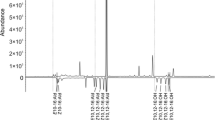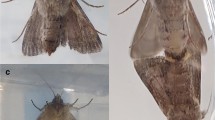Abstract
Pheromone based monitoring of insects of conservation value has the potential to revolutionise the way in which surveys are carried out. However, due to their effective use in pest management, concerns have been raised about potential negative effects of pheromone exposure on populations of rare insects. The effect of exposure to synthetic pheromone lures on male mating behaviour was examined in laboratory and field conditions using the six spot burnet moth Zygaena filipendulae (Linnaeus, 1758). For the laboratory experiment larvae were collected and cultured separately under controlled conditions. Virgin males were exposed to a synthetic pheromone lure for 24 h; then tested for responsiveness immediately after this exposure, 1 and 24 h later. Control males were tested three times: initially, 1 h later and 24 h later. The time taken for males to detect females, shown by exposure of their anal claspers, and the time taken for males to locate females were recorded. No significant difference was found between the time taken for control and exposed males to detect or locate females, and no significant difference between the proportions of males that successfully located females in exposed and control groups was found. In the field experiment the time males spent in the presence of contained females, both with and without a pheromone lure present, was recorded. Males spent more time in the presence of the females when the pheromone lure was present. Both experiments indicate male Z. filipendulae mating behaviour is not adversely affected by exposure to synthetic pheromone lures.



Similar content being viewed by others
References
Andersson K (2012) Pheromone-based monitoring of Elater ferrugineus as an indicator for species-rich hollow oak stands. Masters Thesis, SLU, Sweden
Andersson K, Bergman KO, Andersson F, Hedenstrom E, Jansson N, Burman J, Winde I, Larsson MC, Milberg P (2014) High-accuracy sampling of saproxylic diversity indicators at regional scales with pheromones: the case of Elater ferrugineus (Coleoptera, Elateridae). Biol Conserv 171:156–166. doi:10.1016/j.biocon.2014.01.007
Bergmann J, Gonzalez A, Zarbin PHG (2009) Insect pheromone research in South America. J Braz Chem Soc 20:1206–1219. doi:10.1590/S0103-50532009000700003
Campbell JF, Mullen MA, Dowdy AK (2002) Monitoring stored-product pests in food processing plants with pheromone trapping, contour mapping, and mark-recapture. J Econ Entomol 95:1089–1101. doi:10.1603/0022-0493-95.5.1089
El-Sayed AM, Suckling DM (2005) Behavioural observations of mating disruption in three lepidopteran pests. Behaviour 142:717–729. doi:10.1163/1568539054729114
Evenden ML, Mclaughlin JR, Czokajlo D (2005) Effects of exposure to pheromone and insecticide constituents of an attracticide formulation on reproductive behaviour of oriental fruit moth (Lepidoptera: Tortricidae). J Econ Entomol 98:334–341. doi:10.1603/0022-0493-98.2.334
Franzén M (2002) Occurrence patterns of butterflies (Rhopalocera) and burnet moths (Zygaenidae) in seminatural pastures in southeastern Sweden and their potential and their potential as indicators of species richness. Masters Thesis, SLU, Sweden
Franzen M, Nilsson SG (2012) Climate dependent dispersal rates in metapopulations of burnet moths. J Insect Conserv 16:941–947. doi:10.1007/s10841-012-9481-4
Franzen M, Ranius T (2004) Habitat associations and occupancy patterns of burnet moths (Zygaenidae) in semi-natural pastures in Sweden. Entomol Fenn 15:91–101
Gendron CM, Kuo TH, Harvanek ZM, Chung BY, Yew JY, Dierick HA, Pletcher SD (2014) Drosophila life span and physiology are modulated by sexual perception and reward. Science 343:544–548. doi:10.1126/science.1243339
Hansson BS (1995) Olfaction in lepidoptera. Experientia 51:1003–1027. doi:10.1007/BF01946910
Hein S, Binzenhöfer B, Poethke HJ, Biedermann R, Settele J, Schröder B (2007) The generality of habitat suitability models: a practical test with two insect groups. Basic Appl Ecol 8:310–320. doi:10.1016/j.baae.2006.09.012
Huang J, Stelinski LL, Gut LJ (2010) Mating behaviours of Cydia pomonella (Lepidoptera: Tortricidae) as influenced by sex pheromone in electrostatic powder. J Econ Entomol 103:2100–2106. doi:10.1603/EC10063
Larsson MC, Svensson GP (2009) Pheromone monitoring of rare and threatened insects: exploiting a pheromone–kairomone system to estimate prey and predator abundance. Conserv Biol 23:1516–1525. doi:10.1111/j.1523-1739.2009.01263.x
Miller JR, McGhee PS, Siegert PY, Adams CG, Huang J, Grieshop MJ, Gut LJ, Hildebrand JG (2010) General principles of attraction and competitive attraction as revealed by large-cage studies of moths responding to sex pheromone. Proc Natl Acad Sci USA 107:22–27. doi:10.1073/pnas.0908453107
Musa N, Andersson K, Burman J, Andersson F, Hedenström E, Jansson N, Paltto H, Westerberg L, Winde I, Larsson MC, Bergman KO, Milberg P (2013) Using sex pheromone and a multi-scale approach to predict the distribution of a rare saproxylic beetle. PLoS One 8:1–10. doi:10.1371/journal.pone.0066149
Nansen C, MacDonald KM, Rogers CD, Thomas M, Poppy GM, Baxter IH (2007) Effects of sex pheromone in electrostatic powder on mating behaviour by Lobesia botrana males. J Appl Entomol 131:303–310. doi:10.1111/j.1439-0418.2007.01167.x
Onufrieva KS, Thorpe KW, Hickman AD, Tobin PC, Leonard DS, Roberts EA (2010) Effects of SPLAT® GM sprayable pheromone formulation on gypsy moth mating success. Entomol Exp Appl 136:109–115. doi:10.1111/j.1570-7458.2010.01009.x
Priesner E, Naumann CM, Stertenbrink J (1984) Specificity of synthetic sex-attractants in Zygaena moths. Z Naturforsch C 39:841–844
Rakosy L, Schmitt T (2011) Are butterflies and moths suitable ecological indicator systems for restoration measures of semi-natural calcareous grassland habitats? Ecol Indic 11:1040–1055. doi:10.1016/j.ecolind.2010.10.010
Schmitt T (2003) Influence of forest and grassland management on the diversity and conservation of butterflies and burnet moths (Lepidoptera, Papilionoidea, Hesperiidae, Zygaenidae). Anim Biodivers Conserv 26:51–67
Sharov AA, Thorpe KW, Tcheslavskaia K (2002) Effect of synthetic pheromone on gypsy moth (Lepidoptera: Lymantriidae) trap catch and mating success beyond treated areas. Environ Entomol 31:1119–1127. doi:10.1603/0046-225X-31.6.1119
Skals N, Anderson P, Kanneworff M, Löfstedt C, Surlykke A (2005) Her odours make him deaf: crossmodal modulation of olfaction and hearing in a male moth. J Exp Biol 208:595–601. doi:10.1242/jeb.01400
Spitzer L, Benes J, Dandova J, Jaskova V, Konvicka M (2009) The large blue butterfly Phengaris [Maculinea] arion as a conservation umbrella on a landscape scale: the case of the Czech Carpathians. Ecol Indic 9:1056–1063. doi:10.1016/j.ecolind.2008.12.006
Stelinski LL (2007) On the physiological and behavioural mechanisms of pheromone based mating disruption. Pestycydy 3:27–32
Stelinski LS, Gut LJ, Vogel KJ, Miller JR (2004) Behaviours of naïve vs. pheromone-exposed leafroller moths in plumes from high-dosage pheromone dispensers in a sustained-flight wind tunnel: implications for mating disruption of these species. J Insect Behav 17:533–554. doi:10.1023/B:JOIR.0000042540.09188.eb
Stelinski LL, Gut LJ, Ketner KC, Miller JR (2005a) Orientational disruption of codling moth, Cydia pomonella (L.) (Lep., Tortricidae), by concentrated formulations of microencapsulated pheromone in flight tunnel assays. J Appl Entomol 129:481–488. doi:10.1111/j.1439-0418.2005.01005.x
Stelinski LL, Gut LJ, Mallinger RE, Epstein D, Reed TP, Miller JR (2005b) Small plot trials documenting effective mating disruption of oriental fruit moth by using high densities of wax-drop pheromone dispensers. J Econ Entomol 98:1267–1274. doi:10.1603/0022-0493-98.4.1267
Stelinski LS, Gut LJ, Miller JR (2013) An attempt to increase efficacy of moth mating disruption by co-releasing pheromones with kairomones and to understand possible underlying mechanisms of this technique. Environ Entomol 42:158–166. doi:10.1603/EN12257
Svensson GP, Oleksa A, Gawronski R, Lassance JM, Larsson MC (2009) Enantiomeric conservation of the male-produced sex pheromone facilitates monitoring of threatened European hermit beetles (Osmoderma spp.). Entomol Exp Appl 133:276–282. doi:10.1111/j.1570-7458.2009.00923.x
Tcheslavskaia KS, Thorpe KW, Brewster CC, Sharov AA, Leonard DS, Reardon RC, Mastro VC, Sellers P, Roberts EA (2005) Optimization of pheromone dosage for gypsy moth mating disruption. Entomol Exp Appl 115:355–361. doi:10.1111/j.1570-7458.2005.00266.x
Welter SC, Pickel C, Millar JG, Cave F, Van Steenwyk RA, Dunley J (2005) Pheromone mating disruption offers selective management options for key pests. Calif Agric 59:16–22. doi:10.3733/ca.v059n01p16
Witzgall P, Stelinski L, Gut L, Thomson D (2008) Codling moth management and chemical ecology. Annu Rev Entomol 53:503–522. doi:10.1146/annurev.ento.53.103106.093323
Witzgall P, Kirsch P, Cork A (2010) Sex pheromones and their impact on pest management. J Chem Ecol 36:80–100. doi:10.1007/s10886-009-9737-y
Acknowledgments
We would like to thank the Royal Society for funding this work, as well as Canterbury Christ Church University for the use of their facilities and grassland plants and insects.
Author information
Authors and Affiliations
Corresponding author
Rights and permissions
About this article
Cite this article
Oleander, A., Thackery, D. & Burman, J. The effect of exposure to synthetic pheromone lures on male Zygaena filipendulae mating behaviour: implications for monitoring species of conservation interest. J Insect Conserv 19, 539–546 (2015). https://doi.org/10.1007/s10841-015-9775-4
Received:
Accepted:
Published:
Issue Date:
DOI: https://doi.org/10.1007/s10841-015-9775-4




